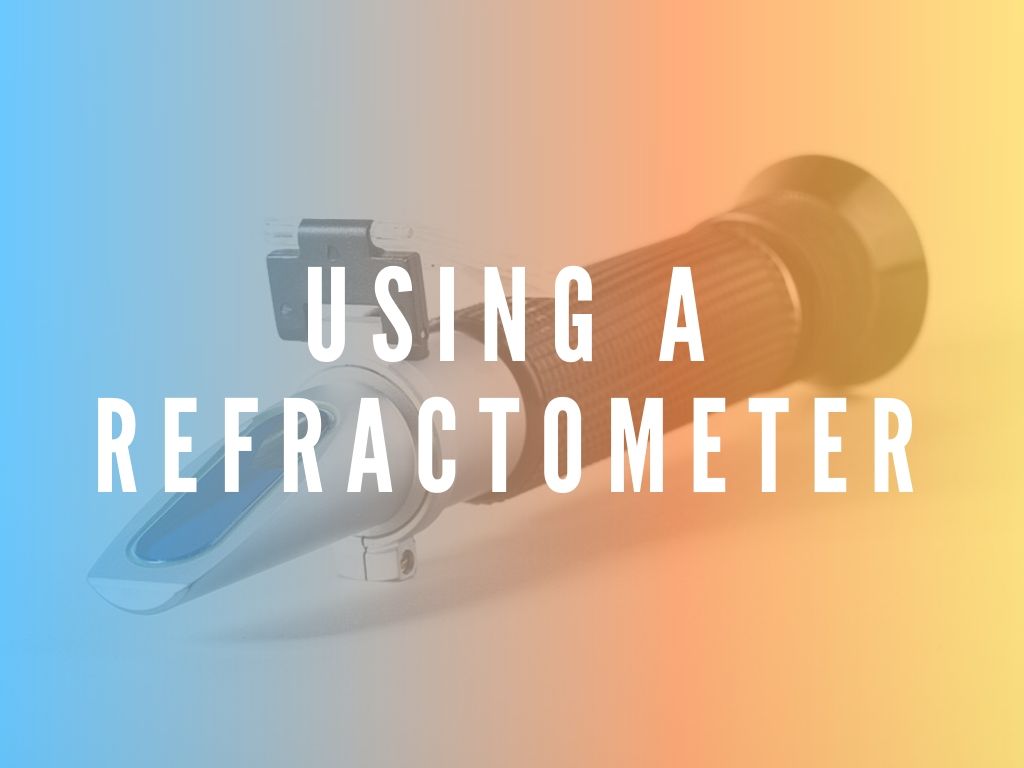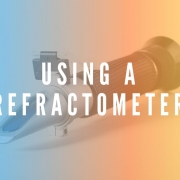Using A Refractometer

Using a refractometer is possibly the quickest and easiest way to check gravity throughout the brewing process. A refractometer is not as commonly used by homebrewers as a hydrometer but I find using one is much easier for quick readings so this article is an explainer on how to use a refractometer.
The modern homebrewer has a wide range of tools available to them for virtually any part of the brewing process. From volume to temperature, from pH to time, different variables will have a different impact on the beer or wines taste, flavor, texture, and even color.
When it comes to precision and sensitivity, it’s hard to argue with the fact that wort and beer gravity is one of the most important pieces of information.
Table of Contents
Gravity Readings
By knowing exactly how much sugar is contained in your wort or must it’s possible to estimate the exact efficiency of your brewing system, which in turn will allow you to draft your recipes with more precision.
Knowing the final gravity after fermentation will help you understand how well this or that strain of yeast is able to attenuate a beer in given conditions. So it’s obvious that having a precise tool to measure this variable is quite helpful.
Refractometer Or Hydrometer?
The enthusiast brewer usually has access to two distinctly different tools for measuring gravity:
- Hydrometers
- Refractometers
Both rely on different physical principles to achieve the same results, and many brewers tend to argue about the virtues of both. Details of using a hydrometer can be found here.
In this article, however, we’ll focus on refractometers, learning how to use them and what makes them so useful when brewing your own beer.
How A Refractometer Works
A refractometer, as the name suggests, rely on a physical principle called refraction.
When light enters a liquid medium it changes its direction, and you have certainly noticed this trait when looking at an object through a glass full of water.

Depending on the density of the liquid the degree to which the light gets refracted (refractive index) will change, so the density can be measured by measuring the refractive index of a given liquid sample.
Clearly, the amount of sugar contained in beer wort will affect the density of the liquid, and thus it can be measured through refraction. This is exactly how a typical refractometer operates.
Brix & Plato Readings
Most refractometers you will find on the market usually come in Brix scale, and it’s important to discuss this particular system in detail.
Like the Plato scale, which is widely used by European professional brewers (and which is a technical refinement of the Brix scale), the Brix scale measures the exact content of sugar in a liquid solution measured in degrees.
This measurement is very useful when making wine, brewing beer, or dealing with any other liquid substances that rely on exact measurement of sugar content.
That’s why refractometers are particularly popular with winemakers, brewers, and other beverage industry professionals. And if you’re not particularly used to the Brix/Plato scale, it can be easily converted to Specific Gravity.
Moreover, there are many refractometers on the market that come both in Brix and Specific Gravity scales, so this shouldn’t be a problem.
How to use a Refractometer

Using a refractometer is quite simple. And what’s really different compared to a typical hydrometer, you only need several drops of your wort to get an accurate reading. The process is as follows:
Collect a small quantity of your wort, must or wine, beer (usually done with a droplet that comes with the hydrometer)
Lift up the sample plate so that the blue surface is exposed
Place a few droplets on the blue window then close the sample plate and let the liquid spread evenly, avoid bubbles
Let the liquid reach room temperature (or the calibration temperature noted in the refractometer)
Look into the refractometer viewfinder by holding it against a bright light
Adjust the focus by turning the focus ring if necessary so that the numbers on the scale look clear and sharp
Measure where the coloured section starts against the numeric scale – this is the actual reading of the liquid
As you can see, the process is really simple and fast. And you don’t need to collect a considerable amount of liquid like in case of a hydrometer. This is why so many brewers and winemakers prefer using a refractometer.
How To Calibrate A Refractometer
It’s very important to keep the refractometer calibrated when taking measurements, otherwise you’ll be getting erroneous information from your readings. Fortunately, it’s quite easy to do and doesn’t require any special instruments:
Open the sampling port
Remove any remaining liquids with a cloth if there are and apply several drops of pure distilled water
Close the sampling port, let the water reach room temperature, avoid any bubbles
Look into the refractometer viewfinder by holding it against a bright light
The coloured zone should start at 0° Brix in case of distilled water
If the reading is other than 0, use a small screwdriver (usually comes with the refractometer) and turn the small screw on top of the refractometer until it hits zero exactly
In order to make the most out of your refractometer and prolong its usefulness, make sure to store it in a dry place with constant temperature, always wipe the sampling port clean after taking the measurement, and avoid any hits or mechanical shock to it.




Hi Neil, been looking for a refractometer for ages & finally got one. It wasn’t expensive but had the best reviews. Tried it for the 1st time today & it’s miles out, SG on the hydrometer read 1010, SG on refractomter read 1034. I followed the instructions correctly so I guess I just got a bad one. Can you
recommend one, as I am struggling to find a quality replacement?
Cheers
I am not sure I can recommend one without knowing your budget and so on. It may be that the refractometer wasn’t calibrated correctly, have you contacted the company who supplied the refractometer? Did you try a reading with just water to test the calibration.
Thanks for your response Neil,
I did try with water & had to adjust it a tiny bit to get back down to zero, then done a hydrometer reading of a finished wine to compare. I did read somewhere that due to the alcohol an adjustment would need to be made. I want to be able to use it to test a must prior to fermentation, then to check at the end & when back sweetening. I would pay up to £80 or so for a half decent one.
Cheers